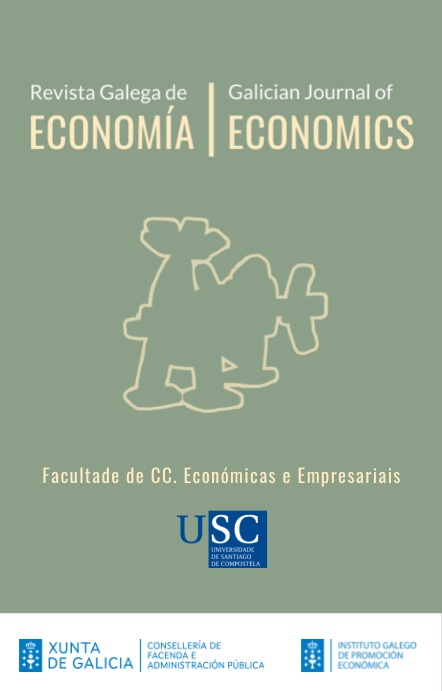UNHA PERSPECTIVA COMBINADA PARA ACCEDER A CAMBIOS A CURTO PRAZO NA SITUACIÓN ECONÓMICA DE PORTUGAL E ESPAÑA
Contido principal do artigo
Resumo
actividade económica. Usamos unha perspectiva baseada nas opinións de varios recoñecidos
economistas españois e portugueses sobre a importancia dun grupo de indicadores
individuais aceptados de forma xeral, que poidan avaliar a situación económica. O obxectivo
do artigo é o de determinar a posición económica relativa nun período de tempo a curto e
medio prazo e analizar a importancia da opinión dos economistas para describir a situación
económica. Recolléronse datos trismestrais do período de 1995 a 2014 (1º semestre) das
estadísticas da OECD.StatExtracts para Portugal e España. Os resultados apoian a idea de que
as opinións dos economistas son importantes para explicar as características dunha
economía. Malia que as súas opinións sobre o peso dunha variable determinada na
descrición do nivel de actividade económica pode variar, implicitamente a longo prazo todas
las opinións tenden a converxer nun mesmo patrón de evolución dunha situación económica.
Palabras chave
Detalles do artigo
Citas
ANTONAKAKIS, N.; AND COLLINS, A. (2014):” The impact of fiscal austerity on suicide: On the empirics of a modern Greek tragedy”, Social Science & Medicine, 112, pp. 39-50.
ALTÍSSIMO, F.; BASSANETTI, A.; CRISTADORO, R.; FORNI, M.; LIPPI, L., AND VERONESE, G. (2001): EuroCoin: A Real Time Coincident Indicator of the Euro Area Business Cycle, Centre of Economics Policy Research (CEPR), Discussion Papers Series, nº 3108, 1-46.
AZEVEDO, J. V. (2011), “A Multivariate Band-Pass Filter for Economic Time Series”, Journal of Royal Statistical Society, 60(1), pp. 1-30.
AZEVEDO, J. V. AND PEREIRA, A. (2013), “Approximating and Forecasting Macroeconomic Signals in Real-Time”, International Journal of Forecasting, 29(3), pp. 479-492.
AZEVEDO, J. V.; KOOPMAN, S. J. AND RUA, A. (2006): “Tracking the Business Cycle of the Euro Area: A Multivariate Model-Based Bandpass Filter”, Journal of Business & Economic Statistics, 24 (3), pp. 278-290.
BLYTH, M. (2013): “Austerity: The history of a dangerous idea”, New York: Oxford University Press.
BRADY, G. L. (2015): “Austerity in the European Union: Keynesian stimulus versus fiscal consolidation”, Atlantic Economic Journal, 43(1), pp. 55-65.
BRANAS, C. C.; KASTANAKI, A. E.; MICHALODIMITRAKIS, M.; TZOUGAS, J.; KRANIOTI, E. F., THEODORAKIS; P. N.; . . . WIEBE, D. J. (2015): ”The impact of economic austerity and prosperity events on suicide in Greece: A 30-year interrupted time-series analysis”. BMJOpen, 5(1), e005619-2014-005619. doi:https://doi.org/10.1136/bmjopen-2014-005619
CAFRUNY, A.; RYNER, J. (2007): “Europa at bay. The Shadow of US Hegemony”, London: Lynne Rienner Publishing.
CALCAGNO, A. (2012): “Can austerity work. Review of Keynesian Economics”, 1(1), pp. 2436.
CARRASCO, C. (2014):“Origen de los desequilibrios macroeconómicos en la economía española. Problemas Del Desarrollo”, 45(179), pp. 91-115.
CHANG, H. (2012): “23 things they don't tell you about capitalism”, New York: Bloomsbury Publishing.
COCHRANE, J. H. (2011): “Understanding policy in the great recession: Some unpleasant fiscal arithmetic”, European Economic Review, 55(1), pp. 2-30.
DELLEPIANE, S.; HARDIMAN, N. (2013):”The politics of fiscal effort in Spain and Ireland: Market credibility versus political legitimacy”, Dublin: Geary Institute.
Dias, F. C. (2003): “The Coincident Indicator of the Portuguese Economy: An Historical Assessment After Ten Years”, Banco de Portugal / Economic bulletin, September 2003, Articles, pp. 93-100.
EUROPEAN CENTRAL BANK (2001): The Information Content of Composite Indicators of the Euro Area Business Cycle. ECB Monthly Bulletin, November 2001, pp. 39-50.
FAMA, E. (2009): “Bailouts and stimulus plans”. In Fama/French Forum, vol. 13.
FLASSBECK, H.; LAPAVITSAS, C. (2015): “Confronting the failure of the European monetary union” In J. Jäger, & E. Springler (Eds.) “Asymmetric crisis in Europe and possible futures. Critical political economy and post-Keynesian perspectives”, pp. 131-148, Oxon: Routledge.
HANNSGEN, G. (2012): “A brief guide to the US stimulus and austerity debates”, New York: Levy Economics Institute.
HICKS, C. (1982): “Fundamental Concepts in the Design of Experiments”, 3th edition, Holt, Rinehart and Winston, New York.
HUSSON, M. (2015): “Unemployment, working time and financialisation: The French case”, Cambridge Journal of Economics, 39(3), pp. 887-905.
JÄGER, J.; SPRINGLER, E. (2015): “Asymmetric crisis in Europe and possible futures: Critical political economy and post-Keynesian perspectives”, Oxon: Routledge.
KITROMILIDES, Y. (2011): “Deficit reduction, the age of austerity, and the paradox of insolvency”, Journal of Post Keynesian Economics, 33(3), pp. 517-536.
KONZELMANN, S. (2012): “The economics of austerity”, Cambridge, ESRC Centre for Business Research.
LAVOIE, M. (2015): “The Eurozone: Similitudes and differences with Keynes’s plan”. Düsseldorf: IMK Working Paper.
OGUJIUBA, K. K.; EHIGIAMUSOE, K. (2014): “Capital budget implementation in Nigeria: Evidence from the 2012 capital budget”, Contemporary Economics, 8(3), pp. 293-314.
RUA, A. (2004): “A New Coincident Indicator for the Portuguese Economy”, Banco de Portugal / Economic bulletin, June 2004, Articles, pp. 21-28.
STOCK, J.; WATSON, M.W. (1989): “New Indexes of Coincident and Leading Economic Indicators”, in O. J. Blanchard and S. Fischer (ed.): NBER Macroeconomics Annual 1989, Volume 4, pp. 351-408. MIT press.
STORM, S.; NAASTEPAD, C. (2015): “Europe’s hunger games: Income distribution, cost competitiveness and crisis”, Cambridge Journal of Economics, 39(3), pp. 959-986.






